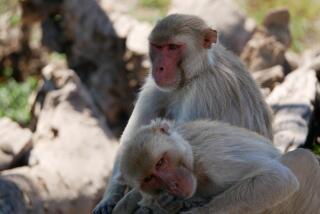Child-Rearing and Social Togetherness
- Share via
Who is minding the kids? And why? Not just your kids and my kids but baby elephants and giraffes? Are aunts better sitters than older sisters, and do both take better care of the young than unrelated strangers? Most important, does the answer explain something about the evolution of social behavior?
A group of zoologists met in England last month to compare the animal and human socioecology (that is, the patterns in social behavior that relate to the entire ranges of influences to which an individual is exposed). They talked mostly about group-living mammals, and about the advantages of social living. Their underlying assumption was that most individual animals would prefer to live alone, but that individuals accept the innate discomfort of social living because of the benefits.
The obvious advantages of living in a group include having help fighting predators and pooled access to food. Once animals are living together, it was suggested, they begin to help each other. And one way they cooperate is in communal child care.
It seems to me it might have been the other way around. Animals began to live together to share infant care, and then they began cooperating in their search for food and defense. This makes more sense because in most species it is the females that live in groups into their adult lives. They band together to supply their offspring with food and to protect the fragile youngsters from danger. Males of these species often just wander around alone or in bachelor pairs.
Lots of mammal mothers take turns baby-sitting. Small giraffes sit in the high grass during the hot daylight hours with a single adult female guarding them while the other mothers browse for food. At the first sign of danger, the guardian herds her own youngster to safety and the other baby giraffes, alert to her actions, follow. By taking turns at the creche, the adult females have more time and freedom to eat their fill, and pass on the nourishment to their nursing offspring.
Elephants have a different approach. They also live in female groups, but theirs seems to have a stricter hierarchy. The dominant female gets first access to the males during their infrequent mating seasons, and she usually bears her offspring earliest in the season. Baby elephants are vulnerable for the first two years of their lives, during which time the help of other members of the group is crucial. All baby elephants do not receive the same amount of attention, according to Phyllis Lee of Cambridge University. She reported at the April meeting that life expectancy among baby elephants is directly related to the amount of oversight they receive. Observing elephants with Cynthia Moss at Abroseli National Park, in Kenya, she calculated that infant mortality can be twice as high among the offspring of females on the fringes of the group that have few relatives as compared to those whose mothers are at the center.
Infant elephants, like small children, prefer to play with animals their own age rather than their older sisters and brothers. As they wander around their territory, adolescent females watch over and protect them. Those born earliest in the season get the most care, and so do those with lots of sisters, and aunts to help watch over them.
It seems that the advantages of communal child care may have triggered the evolution of the complex social systems we see among mammals such as giraffes and elephants. And this is because aunts and sisters have an interest in the survival into future generations of individuals with whom they share genetic material. What is the evolutionary future of humans, the only species to have radically altered the pattern of animal lives?
We are the only species who, by our own ingenuity, have extended the lifetimes of both males and females so that many of us will live at least half of our lives after our children are grown. If the need to care for offspring triggered sociality and a tight family structure, what are the implications for a society of post-reproductive adults?
Did we become communal 40,000 years ago to protect our children from the elements, from other animals, and from each other only to lose the need for this kind of sociality? The future presents two possibilities. We may see large patriarchal or matriarchal families in which great-grandparents and even great-great-grandparents guard the welfare of their descendants, or we may see a return to solitary living among older, independent adults who feel increasingly remote from those descendants and who are instead interested primarily in their own welfare.
More to Read
Sign up for Essential California
The most important California stories and recommendations in your inbox every morning.
You may occasionally receive promotional content from the Los Angeles Times.












